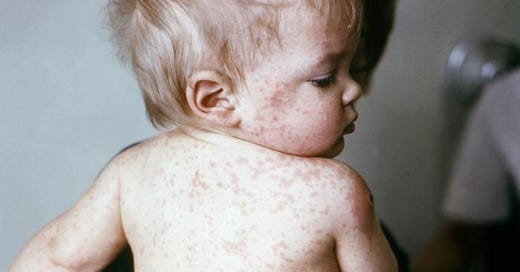
Yesterday the US measles outbreak claimed its second US victim this year, an unvaccinated adult in New Mexico. As of Tuesday, Texas health officials have confirmed 159 measles cases and 22 hospitalizations. Measles cases have also been confirmed in New Mexico, Georgia, Rhode Island, Alaska, New York City, and my home state of New Jersey. Here are five things about measles you might not know.1
Measles is by far the most contagious disease we know of. On average, a person with flu may infect two or three other people within an hour; a person with measles will infect up to 18 people. If 100 people gather in a large room for an hour, if one of them has the flu, two or three people in their vicinity may come down with flu—but if one of them has measles, 90 percent of all unprotected people in the room will get measles.
This is partly because the measles virus is virulent in very small quantities related to the unique way it interacts with the human body. A person who comes down with flu has typically been exposed to the virus in concentrations normally localized around the source. The measles virus is virulent in tiny quantities carried in even low concentrations of aerosolized droplets, which remain fully airborne for hours. This means you can catch measles simply passing through a room hours after an infected person left the room. Another factor: carriers are contagious long before they have symptoms.
A nasty side effect of measles is that it wipes out the immune system’s “memory” of existing immunities, at least for years and possibly for life. This “immune amnesia,” discovered in 2012 and confirmed in 2019, leaves people far more vulnerable to everything they’ve been exposed to or even immunized against. Thus, measles vaccinations lower mortality rates from other diseases, partly by preventing this immune system reset.2
Complications of measles include:
In the US, 20 to 40 percent of measles patients require hospitalization.
Among children with measles, about 1 in 10 develop ear infections; up to 1 in 20 get pneumonia; and 1 in 1,000 develop brain swelling which can lead to convulsions, deafness, and intellectual disability.
Worldwide, measles kills over 100,000 people every year. Before widespread vaccination, major epidemics every two or three years killed an estimated 2.6 million people a year.
Measles vaccine effectiveness is very high—about 97%—but not everyone can be vaccinated, and high vaccination rates help protect everyone, including those who can’t be vaccinated and the tiny number of vaccinated people who may be unprotected despite being vaccinated.3 For measles, a 95% vaccination rate or higher is needed for herd immunity. By 2000 we had achieved this, to the point that measles was declared eradicated from the US. With the spread of social vaccine resistance and antivax ideology and misinformation, though, vaccination rates are down and unvaccinated Americans, including those who cannot be vaccinated, are again unprotected. Measles rates this year are three times higher than last year.
For what it’s worth, while I’m not a medical professional, I’m married to one. As always when writing on topics on which I am not myself an expert, I welcome comments and corrections from those who know more than I do. Antivax propaganda, however, will be deleted with prejudice.
Update: Since publication, I edited points 2 and 3 for clarification and simplicity as well as accuracy, among other things removing Covid as a point of comparison. The infectiousness of Covid is a complex topic with a muddled history, research around which has clarified our understanding of infectious disease in general, including a new understanding of airborne disease. Thanks to my smart friend
for drawing my attention to unclear wording and for helping me craft a more precise and accurate treatment!In some cases, vaccine effectiveness erodes over time, and medical professionals may need to be checked for current immunity, and may need boosters if they aren’t still immune.





Deacon Steve, it is not true that COVID transmission occurs mostly through "large, heavy secreted droplets usually limited to a radius of about six feet of the infected person." Although public health institutions have for historical reasons been tragically reluctant to acknowledge that SARS-CoV-2 is carried on small light particles, the evidence for airborne transmission of COVID is overwhelming.
https://pmc.ncbi.nlm.nih.gov/articles/PMC9538841/
Keeping six feet apart from infected persons is protective for a different reason, namely, that these light airborne particles are most concentrated closest to their source (see Figure 1).
From RFK Jr yesterday, I didn’t see this coming, “Measles is a highly contagious respiratory illness with certain health risks, especially to unvaccinated individuals,” and “We must engage with communities to understand their concerns, provide culturally competent education, and make vaccines readily accessible”